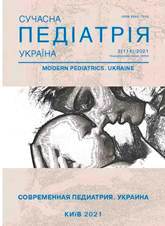Clinical and paraclinical markers of inflammatory activity in acute tonsilopharyngitis in children
DOI:
https://doi.org/10.15574/SP.2021.114.8Keywords:
acute tonsillopharyngitis, children, clinic, C-reactive proteinAbstract
Purpose — to study clinical and paraclinical markers of inflammatory activity in acute non-streptococcal and streptococcal tonsillopharyngitis in children to address rational treatment tactics.
Materials and methods. To achieve this goal, a comprehensive examination of 102 children with acute tonsillopharyngitis, which was divided into two clinical groups depending on the isolation of beta-hemolytic streptococcus group A during a culture of smears from the mucosa of the tonsils/pharynx. The first (I) clinical group included 68 patients in whom bacteriological examination did not reveal BGSA — GTP of non-streptococcal etiology (nGTP). And 34 children in whom the streptococcal etiology of the disease was determined formed the second (II) clinical group — streptococcal acute tonsillopharyngitis (cGTP).
Results. The presence of a subfebrile body temperature in the child increased its post-test probability by 27.4%, and higher fever figures reduced the probability of non-streptococcal GTP by only 4.3%. The absence of symptoms of intoxication syndrome in children with a high degree of specificity — 91.4% confirms the non-streptococcal nature of the disease. Expressive layers on the tonsils are more characteristic of streptococcal GTP, and the assessment of their severity <3 points was much more common in patients with non-streptococcal disease. When using the determination of the content of C-reactive protein <50.0 mg/l in the venous blood of children as a test, allows you to verify the non-streptococcal nature of acute tonsillopharyngitis with a fairly high sensitivity — 73.5% (95% CI 63.7–81.8), however, low specificity — 35.3% (95% CI 26.0–45.5).
Conclusions. Indicators of local inflammation and clinical manifestations of the general inflammatory reaction were less pronounced in patients with non-streptococcal GTP. Indicators of C-reactive protein <50.0 mg/l in venous blood with high sensitivity (73.5%; 95% CI 63.7–81.8) and relative risk 1.2 (95% CI 1.0–1.5) probably testified in favor of the nonstreptococcal nature of acute tonsillopharyngitis.
The research was carried out in accordance with the principles of the Helsinki Declaration. The study protocol was approved by the Local Ethics Committee of these Institutes. The informed consent of the patient was obtained for conducting the studies.
No conflict of interest was declared by the authors
References
Gonzalez Fernandez N, Herrero-Morin JD, Solis Sanchez G, Perez Mendez C, Molinos Norniella C, Pardo de la Vega R, Crespo Hernandez M. (2012). Variability of antibiotic treatment in paediatric acute pharyngoton-sillitis in Asturias, Spain. Arch Argent Pediatr. 110 (3): 207-213. https://doi.org/10.5546/aap.2012.207; PMid:22760746
Karneeva OV, Dajhes NA, Polyakov DP. (2015). Protocols for the diagnosis and treatment of acute tonsillopharyngitis. RMJ. Otorinolaringologiya. 6: 307-311.
Kirichenko IM. (2018). Znachenie topicheskoy protivovospalitelnoy terapii v lechenii ostryih tonzillofaringitov u detey. Bronhopulmonologiya i LOR. Meditsinskiy sovet. 17: 114-117.
Kolosova NG, Geppe NA, Dronov IA. (2019). Approaches to the treatment of bacterial infections of the respiratory tract based on current data of the microbiome. Ros Vestn Perinatol i Pediatr. 64 (1): 125-129. https://doi.org/10.21508/1027-4065-2019-64-1-125-129
MZ RF. (2016). Acute tonsillopharyngitis. Clinical guidelines. KR. 306: 6-18.
Payganova N.E. (2019). Sovremennyie tendentsii v lechenii ostrogo tonzillofaringita u detey (obzor klinicheskogo issledovaniya). Pediatriya. Consilium Medicum. 3: 87-91. doi: 10.26442/26586630.2019.3.190634.
Tsung-Hsueh Hsieh, Po-Yen Chen, FangLiang Huang, Jiann-Der Wang, Li-Ching Wang, Heng-Kuei Lin, Hsiao-Chuan Lin, Hsin-Yang Hsieh, Meng-Kung Yu, Chih-Feng Chang, TzuYau Chuang, Chin-Yun Lee. (2011). Are empiric antibiotics for acute exudative tonsillitis needed in children? Journal of Microbiology, Immunology and Infection. 44: 328-332. https://doi.org/10.1016/j.jmii.2010.08.009; PMid:21524968
Downloads
Published
Issue
Section
License
Copyright (c) 2021 Modern Pediatrics. Ukraine

This work is licensed under a Creative Commons Attribution-NonCommercial 4.0 International License.
The policy of the Journal “MODERN PEDIATRICS. UKRAINE” is compatible with the vast majority of funders' of open access and self-archiving policies. The journal provides immediate open access route being convinced that everyone – not only scientists - can benefit from research results, and publishes articles exclusively under open access distribution, with a Creative Commons Attribution-Noncommercial 4.0 international license (СС BY-NC).
Authors transfer the copyright to the Journal “MODERN PEDIATRICS. UKRAINE” when the manuscript is accepted for publication. Authors declare that this manuscript has not been published nor is under simultaneous consideration for publication elsewhere. After publication, the articles become freely available on-line to the public.
Readers have the right to use, distribute, and reproduce articles in any medium, provided the articles and the journal are properly cited.
The use of published materials for commercial purposes is strongly prohibited.

